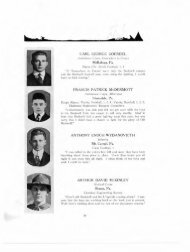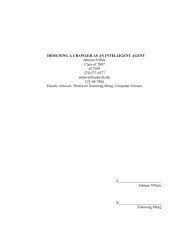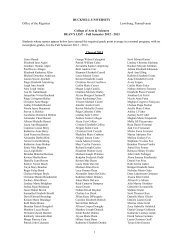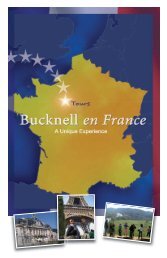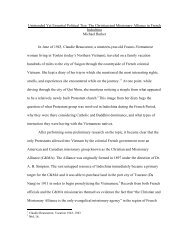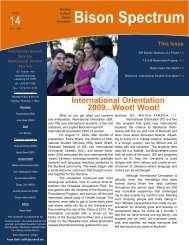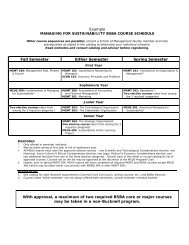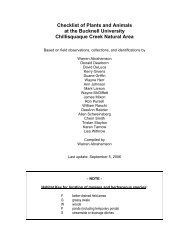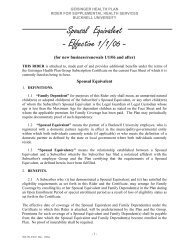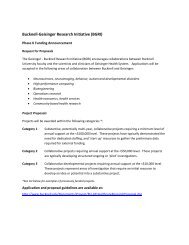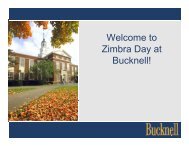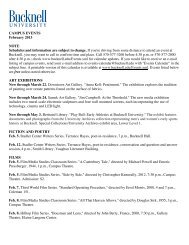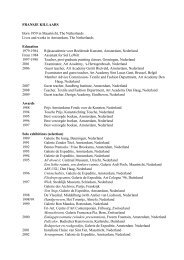Brochure-formated walking tour - Bucknell University
Brochure-formated walking tour - Bucknell University
Brochure-formated walking tour - Bucknell University
You also want an ePaper? Increase the reach of your titles
YUMPU automatically turns print PDFs into web optimized ePapers that Google loves.
FINAL STOP<br />
Back to<br />
the River<br />
Within the last several years,<br />
there has been a desire to reconnect<br />
Sunbury with the river that<br />
was once visible from most of the town. Every<br />
year on the third weekend of August, Sunbury celebrates the<br />
river with a River Festival. The festival is a community development initiative<br />
that includes arts vendors, a car show, Civil War encampments and<br />
cardboard regattas. Currently, the Sunbury Riverfront Project is stabilizing<br />
the wall and improving facilities to encourage citizen use of the river and<br />
riverfront area.<br />
“<br />
My great grandparents, grandparents, parents, wife<br />
and I all have enjoyed Sunbury as a wonderful place<br />
to live, practice law and to raise and educate our children.<br />
Jane and I came back to Sunbury to give our<br />
children the enjoyment of the same life I had growing<br />
up here - and they really appreciated it.<br />
”<br />
John A. Carpenter<br />
Sunbury’s relationship with the resources of the area have been crucial to<br />
the development of Sunbury’s rich history. From the river to industry, and<br />
from railroads to modern day, the city has certainly been through its share of<br />
booms and busts, but all the while it has remained a great place to be.<br />
Acknowledgements<br />
The developers of this <strong>walking</strong> <strong>tour</strong> would like to thank the following people<br />
for their efforts and contributions without which this brochure would not<br />
have been possible.<br />
John A. Carpenter<br />
Cheryl Delsite<br />
Debbie Hirsch<br />
Bob Lagerman<br />
FOR MORE INFORMATION AND A LIST OF SOURCES,<br />
PLEASE VISIT: http://www.bucknell.edu/x77663.xml<br />
Ben Marsh<br />
Kristin McLaughlin<br />
David Persing<br />
Terry Specht<br />
Sunbury, PA<br />
Self-Guided Historical<br />
Walking Tour<br />
Exploring how natural resource use and development in<br />
Sunbury and the surrounding region shaped its history<br />
Developed by:<br />
Molly Clark<br />
Joanna Freeman<br />
Garyn Tate<br />
Melinda Thomas<br />
Katelyn Tsukada<br />
<strong>Bucknell</strong> <strong>University</strong><br />
ENST 411 Spring 2012
Fort Augusta<br />
Fort Augusta and the Hunter House<br />
Museum is less than a mile north<br />
of the first stop on the <strong>walking</strong> <strong>tour</strong>.<br />
This historical site sets up the preindustrial<br />
context of Shamokin, the<br />
Native American name for modern<br />
day Sunbury. Currently, the Hunter<br />
House Museum provides visitors with<br />
information on local Native Americans<br />
including the Shawnee and Lepane tribes who occupied<br />
Sunbury and Packer Island. Fort Augusta, erected in 1756,<br />
was the original stronghold of the Susquehanna Valley from<br />
the French and Indian War until the close of the American<br />
Revolution.<br />
PRELIMINARY STOP<br />
As you drive south to the first stop on the <strong>walking</strong> <strong>tour</strong>, be sure to<br />
notice the large concrete flood wall lining the river on the right.<br />
The Susquehanna<br />
STOP<br />
1 Since the founding of Sunbury, the river has played an<br />
essential role in economic development, transportation<br />
and infrastructure in the area. In 1932,<br />
a devastating flood destroyed most of<br />
downtown Sunbury, causing structural<br />
damage and claiming lives. The flood<br />
wall was erected in 1951 as a means<br />
of protection against future natural<br />
disaster of this magnitude. It saved<br />
Sunbury just twenty years later<br />
during Hurricane Agnes when<br />
the Susquehanna River rose to<br />
the level of the wall. This barrier<br />
is both a protective measure and<br />
isolating boundary, underlining<br />
Sunbury’s unique position as a<br />
fragile river community.<br />
River Flood Wall<br />
13<br />
STOP<br />
Cole’s Hardware<br />
Store<br />
The Chestnut Street Opera House opened on September 12, 1901 and<br />
was the home to over 400 vaudeville acts in the early 1900’s. Traveling<br />
shows would perform in the house, which seated one thousand people,<br />
until it closed in 1936 due to the flood and increasing popularity of<br />
motion pictures. The opera house is currently owned and operated by<br />
Cole’s Hardware but the unchanged exterior is a tribute to the building’s<br />
former glory. As trains were replaced by automobiles, Sunbury’s<br />
coveted location and rail lines could not support the bustling downtown<br />
it had created. Many Market Street businesses were forced to<br />
close their doors. When the Susquehanna Valley Mall was built in 1978<br />
several more businesses closed in response. This opera house turned<br />
hardware store is evidence of the changes that have taken place in Sunbury<br />
but also demonstrates pride and a stronghold to the town’s lucrative<br />
past.<br />
14<br />
STOP<br />
Weis Markets<br />
In 1912 two Sunbury residents,<br />
Harry and Sigmund Weis founded<br />
Weis Markets on Market Street.<br />
There are currently 159 stores<br />
throughout Pennsylvania, New<br />
York, New Jersey, West Virginia<br />
and Maryland. Sunbury remains<br />
the corporate headquarters of Weis<br />
and also houses one of their largest<br />
warehouses and shipping centers.<br />
For the past 100 years, Weis Markets<br />
has stood as a testament to the<br />
work ethic and passion present in<br />
the city of Sunbury.
11<br />
STOP<br />
The Squeeze In<br />
Restaurant<br />
The tiny Squeeze In hot dog restaurant has been in Sunbury since 1945. It<br />
holds a record in the Guinness Book of World Records. The current owner<br />
of the Restaurant bought it because he had such fond memories of eating<br />
there, at the faded orange counter, as a child growing up in Sunbury. Several<br />
Sunbury residents recall their first trip to the Squeeze In and also their<br />
children’s’ and grandchildren’s’ first trip. The Squeeze In has fans in Sunbury<br />
and across the country.<br />
Side trip: If you’re interested in a<br />
walk up the hill, you’ll find the Mary<br />
Packer House which once served as<br />
the home for the Packer family. The<br />
house now serves as a nursing home.<br />
First Evangelical<br />
Church<br />
12<br />
STOP<br />
On the corner of Fifth and Chestnut, First Evangelical Church is<br />
a stunning example of Sunbury’s wealth during the late 19th and<br />
early 20th centuries. The breathtaking architecture, imitating<br />
the Pantheon of ancient Rome, recalls a time of prosperity for the<br />
city. You probably noticed several<br />
other magnificent churches along<br />
your walk through the downtown<br />
area. Wealth from the coal<br />
industry in the area supported<br />
these numerous, impressively<br />
built, large churches.<br />
STOP<br />
2<br />
The Maclay<br />
House<br />
William Maclay laid out the City of Sunbury just one year before<br />
commissioning this house in 1773. Maclay was an integral<br />
part of Sunbury’s physical plan as well as America’s newly<br />
found independence. He served the country as an officer in<br />
the Continental Army and became one of the first two Senators<br />
from Pennsylvania in the United States’ First Federal<br />
Congress in 1789. Maclay’s diary is one of the only written<br />
accounts of the Senate debates during the ratification of the<br />
Constitution.<br />
The Clement<br />
House<br />
STOP<br />
3<br />
The Clement House was home to Ira T. Clement, who constructed the first<br />
steam saw mill in the area in 1847. These mills were used to produce goods<br />
out of local lumber from Williamsport during the booming lumber era.<br />
Clement also ran a ferry business to help ship lumber south, further evidence<br />
of Sunbury’s contribution to the lumber boom. The wealth from the<br />
lumber boom encouraged industrialization in Sunbury which led to more<br />
prosperity for the area. The city was home to distilleries, tanneries, brickmaking<br />
factories, textile mills, and foundries among other industries.<br />
Other industry came in the form<br />
of the Silk Mill (right) and the Iron<br />
Works (left).
STOP<br />
4<br />
Northumberland<br />
County Prison<br />
Sunbury’s fifth and most recently<br />
constructed prison was<br />
completed in 1877 and is still<br />
in use today. An earlier prison,<br />
built in 1776, also served as the<br />
county courthouse until both<br />
institutions were separated in<br />
the early 1800’s. following the<br />
turn of the 19th century. The<br />
prison was built in the style of a<br />
medieval fortress by Ira T. Clement<br />
(mentioned above) . This<br />
impressive stone fortress may remind visitors<br />
of a time when public hangings and corporal<br />
punishment were still widely accepted practices<br />
before the turn of the 18th century.<br />
5<br />
Northumberland<br />
County Courthouse<br />
STOP<br />
The Northumberland County Courthouse<br />
was built in 1865. The building itself was<br />
modeled after a Lancaster courthouse<br />
designed by architect Samuel Sloan. The<br />
Courthouse is a symbol of the new life in<br />
Sunbury following the Civil War and the<br />
anthracite coal boom that brought wealth<br />
and fortune to the area. The building is<br />
still used today as Sunbury is the county<br />
seat of Northumberland County.<br />
10<br />
STOP<br />
The Hotel Edison<br />
On July 4th, 1883, the<br />
anniversary of Independence<br />
Day, Thomas<br />
Edison illuminated<br />
his first commercial<br />
building. This hotel,<br />
located right in downtown<br />
Sunbury, was<br />
originally known as<br />
the City Hotel and was<br />
later named the Edison<br />
hotel in a ceremony honoring Thomas Edison. Thomas Edison<br />
returned to the city to attend this ceremony in 1922. The Edison Electric<br />
Illuminating Company was incorporated April 30, 1883. Edison<br />
selected six Pennsylvania towns based on local sources of fuel and local<br />
capital. Sunbury was chosen, along with Williamsport, Shamokin, Mt.<br />
Carmel, Bellefonte and Hazelton, which were all near coal fields, a<br />
perfect source for fuel. Edison recognizing Sunbury’s potential is testimony<br />
to the city’s prime location in terms of utilizing the rich supply of<br />
natural resources in the region. Sunbury was a popular shopping and<br />
vacation destination, with hotels running up and down the bustling<br />
Market Street.<br />
The Neff Hotel (left),<br />
famous for its rooftop<br />
garden restaurant, was<br />
another popular spot<br />
for visitors to rest.
STOP<br />
8<br />
Starting in 1876, the Packer House provided a place for railroad travellers<br />
to rest. John Packer was one of the organizers of the Susquehanna Railroad<br />
Company, founded in 1861. The Packer family was closely connected<br />
to the coal boom of the region and ultimately used their wealth to found<br />
Lehigh <strong>University</strong>. The Packer family remained in the area for years to<br />
come and the legacy of the Packer family can be witnessed throughout<br />
Sunbury. The prominence of the Packer family name in the Pomfret Cemetery,<br />
located on the Hill, is a testament to the families devotion to and<br />
legacy in the area.<br />
The Packer House<br />
STOP<br />
9<br />
The Penn Central Railroad station<br />
was built in 1872 by the Northern<br />
Central Railroad. The line<br />
transported both passengers and<br />
freight between the coalfields of<br />
Eastern Pennsylvania and Baltimore,<br />
Maryland. Because of its<br />
prominence during the railroad<br />
era, Sunbury was an important<br />
stop for six central Pennsylvania<br />
lines. As a result, Sunbury received<br />
wealth from not only the<br />
booming coal industry, but also<br />
from the visitors that stayed in<br />
the many hotels lining its streets.<br />
Trains were constantly running<br />
through the center of town so pedestrian<br />
bridges were constructed<br />
to allow citizens to move from one<br />
side of the tracks to the other.<br />
Penn Central<br />
Railroad Station<br />
Cameron Park<br />
STOP<br />
6<br />
Cameron Park is named after Colonel James<br />
Cameron who led a regiment of infantry<br />
to fight at Battle of 2nd Bull Run in 1862<br />
during the American Civil War. The Northumberland<br />
County Soldiers Monument<br />
is located at the west end of the park<br />
surrounded by canons dating back to the<br />
Civil War. The park was originally used to graze cattle<br />
before the downtown area was constructed and farming moved outside<br />
the city limits.<br />
STOP<br />
7<br />
Lorenzo Da<br />
Ponte Marker<br />
As the sign indicates, Lorenzo Da Ponte was a Venetian opera librettist<br />
and poet. He is most well known for writing the librettos for<br />
three of Mozart’s greatest operas, Don Giovanni, The Marriage of<br />
Figaro and Così fan tutte. While living in Sunbury between 1811 and<br />
1818, he ran a grocery store and gave Italian lessons. Da Ponte and<br />
his wife and sons also built the first three-story building in Sunbury<br />
which served as both residential and commercial space.
³<br />
Early America<br />
Insutrial Era<br />
Railroad Era<br />
Modern Day<br />
RIVER WALK<br />
8<br />
<br />
" 1<br />
FRONT ST<br />
<br />
Start<br />
Here<br />
Sunbury:<br />
" 2<br />
RIVER AVE<br />
<br />
<br />
" 14<br />
ARCH ST<br />
SECOND ST<br />
<br />
At A Glance<br />
" 3<br />
" 4<br />
<br />
" 5<br />
<br />
" 13<br />
" 6<br />
CENTER ST<br />
<br />
" 7<br />
THIRD ST<br />
<br />
" 8<br />
" 9<br />
PENNSYLVANIA AVE<br />
<br />
WOODLAWN AVE<br />
COURT ST<br />
CHESTNUT ST<br />
Use this map for reference as you<br />
complete the historical <strong>walking</strong><br />
<strong>tour</strong>. Each stop is highlighted to indicate<br />
the era during which the stop<br />
held or still holds significance.<br />
<br />
" 10<br />
MARKET ST<br />
AWL ST<br />
<br />
" 11<br />
<br />
" 12<br />
FIFTH ST



